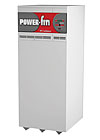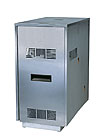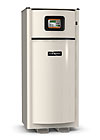
Making products more energy efficient yet still affordable is a challenge that many of the 42 product section manufacturers that make up the Air-Conditioning, Heating, and Refrigeration Institute (AHRI) have had to deal with at some point or another. AHRI is the new trade association formed as a result of a merger of the Air-Conditioning and Refrigeration Institute (ARI) and the Gas Appliance Manufacturers Association (GAMA).
The energy efficiency of many of the products within AHRI’s scope is regulated by federal law. A couple of years ago, it was the residential central air conditioner and water heater manufacturers that had to retool to meet new federal minimum efficiency standards. More recently, the U.S. Department of Energy (DOE) prescribed new minimum efficiency standards for residential furnaces, sparking a lawsuit that is just beginning to make its way through the courts. In each instance, manufacturers and regulators wrestled over such issues as manufacturing cost impact, technological feasibility, distribution networks and estimated payback periods for efficiency gains.

Reacting to DOE's Proposal
Last year, the boiler manufacturers had their day, but rather than accept what the DOE was prepared to propose as the new federal minimum efficiency standard for gas hot water boilers (84% AFUE), the manufacturers directed their then-trade association (GAMA) to negotiate directly with the American Council for an Energy Efficient Economy (ACEEE) and other energy-efficiency advocates to develop a new consensus standard for these products.The agreement they reached called for a new federal minimum for gas hot water boilers of 82% AFUE, coupled with specific energy-saving design features. Also, for oil hot water boilers, the agreement recommended a federal minimum of 84% with one of the mandated design features.
While DOE is charged by Congress with developing minimum energy-efficiency standards for many heating and cooling products, it has become common practice for manufacturers, working through their trade association, to take the initiative and negotiate agreements with energy-efficiency groups on their own, rather than fighting it out, if you will, during the agency’s rulemaking process. Such deal making has been accomplished for large packaged commercial air conditioners; commercial ice makers; commercial refrigerators, freezers, and refrigerator-freezers; and, most recently, for walk-in refrigerators and freezers. All of the consensus agreements, including the boiler agreement, were inserted into the most recent energy bills enacted in 2005 and 2007.
Inclusion of the boiler agreement in the 2007 legislation was a necessity. DOE had concluded it could not accept the agreement because it lacked the legal authority to adopt the mandated design requirements for the covered products.
GAMA had opposed the proposed DOE standard of 84% AFUE for gas hot water boilers because it would have required some consumers to incur great additional expense to ensure safe installation of the boilers. The association felt the consensus standard would benefit consumers by actually saving more energy than the DOE proposal, while avoiding potential safety risks and additional, possibly significant, remodeling costs.
With an aggressive combination of performance and design requirements, the new gas hot water boiler standard calls for the highest technologically achievable, economically justified manufacturing changes to ensure maximum energy savings for consumers and manufacturers.
The standard prohibits standing pilots and mandates that hot water heating boilers be equipped with an automatic means to adjust the temperature of the water supplied by the boiler in response to incremental changes in inferred heat load. When no inferred heat load is evident, such automatic means may not adjust the supply water temperature to more than 140°F. To ensure that this feature is used, the law requires the boiler be operable only when the automatic means are installed.

HE-AB
Series of forced-draft, gas-fired boilers. Source: Bryan
Steam.
Venting Concerns
Concerns about potential venting problems and associated safety issues led GAMA and ACEEE to agree to a combination of a lower minimum AFUE requirement coupled with some energy-saving design features as a better approach than the DOE proposal. As the efficiency of a gas appliance increases, there is less energy available to move the products of combustion through the vent system. There is a wide diversity in the size and configuration of the venting systems that are part of existing residential gas boiler installations.Some of those venting systems may be operating safely and properly at the limits of that particularly configured system’s capacity. Because of this, the boiler manufacturers were concerned that a minimum 84% AFUE, which is near the practical limit of boiler designs that can use traditional type B or masonry chimney vent systems, would require consumers to incur the cost of a new vent system as part of a replacement boiler installation.
In its rulemaking process, DOE attempted to monetize the costs of safe venting, but its estimates assumed quality installations, which are by no means a certainty. With improper installation, the risks of failed venting systems increase. Given the characteristics of the installed base of gas boilers and the current state of venting technology and installation practices, GAMA felt, and ACEEE agreed, that a floor of 82% AFUE struck the appropriate balance between energy conservation and safe and economical venting.
The 84% minimum AFUE requirement for oil-fired hot water boilers recognizes the different characteristics of oil combustion while maintaining the concept of avoiding vent system problems. The new regulation also requires oil boilers to be equipped with automatic means that will adjust the temperature of the water supplied by the boiler in response to incremental changes in inferred heat load.
While the installed base of steam boilers continues to decline, it was recognized that there should be some corresponding increase in their efficiency. Both parties agreed that minimum standards of 82% AFUE for oil steam boilers and 80% AFUE for gas steam boilers were technologically feasible and economically justified.

Power-Fin
Series of gas-fired boilers. Source: Lochinvar Corp.
Design Requirements
It is the general policy of our industry to encourage development of efficiency standards based on performance, rather than design criteria. It is typically easier for manufacturers to design products to meet certain performance standards using methods that work for them, rather than methods that are specified in regulations.In the case of the gas hot water boiler standard, however, both GAMA and ACEEE agreed that two specific design requirements - the ban on standing pilots and the supply temperature reset requirement - were warranted because of their ability to significantly increase energy savings. The current DOE test procedure for determining AFUE does not provide for any energy savings associated with changing the boiler water temperature to match the load. However, both organizations felt that relying on AFUE alone as the basis for boiler efficiency regulation would leave significant energy savings unrealized, so they crafted cost-effective design requirements that would not unduly burden manufacturers or consumers, or stifle innovation.

FX
Series of residential gas-fired boilers. Source: HydroTherm.
Standing Pilot Ban
In 2001, GAMA submitted data to DOE indicating that 97% of baseline 80% AFUE gas hot water boilers had standing pilots. Using its own data, DOE estimated that 27% of 82% AFUE gas hot water boilers are equipped with standing pilots.The AFUE test procedure for boilers discourages the use of standing pilots, but a minimum standard of 82% AFUE does not guarantee that the percentage will drop below 97% (the current baseline) when that becomes the new baseline level. The concern that prompted the standing pilot ban was that installers who prefer standing pilots would demand that manufacturers preserve the standing pilot option, and in the absence of a ban, manufacturers would naturally seek to satisfy that demand.
Thus, only an outright ban on standing pilots would, in the opinion of GAMA and ACEEE, ensure that the nation would realize the full energy savings offered by a move to a minimum standard of 82% AFUE. In fact, using DOE’s assumptions and analytical tools, a standing pilot ban will save from 0.02 to 0.06 quads by 2035 compared to a minimum standard of 82% AFUE, under which the fraction of gas boilers that would have been equipped with standing pilots ranges from 27% (DOE assumption) to 97% (current baseline).
Obviously, the energy savings resulting from the mandated use of electronic ignition will save consumers money. As important, it will payback quickly. Using DOE’s assumed consumer cost for electronic ignition of $92.40 and the agency’s assumption that the consumer realizes a three-year payback when the incremental first cost of an electronic ignition system does not exceed $143, a payback of less than three years appears likely for this particular part.

VF
Series of variable-fire boilers. Source: A.O. Smith.
Mandatory Boiler Temperature Reset
Most baseline boilers are “on-off,” i.e., they cycle up to their high-temperature limit during a call for heat, or until the call for heat is satisfied, and then idle or turn off until the next call for heat. Various methods are employed that can reduce average system temperature by changing the boiler’s high-temperature limit in response to heating load. Reducing average system temperature reduces energy use by reducing system losses and improving average boiler efficiency.“Outdoor reset” is the most well known of these methods, although responding to outdoor temperature is not the only way to lower system temperature without sacrificing comfort.
The term for the general strategy of reducing boiler temperature is “temperature reset.” This technology is not applicable to steam boilers that must produce steam at a fixed temperature regardless of the level of heat demand. The AFUE test does not provide credit for temperature reset because some effects are system-dependent, the “indoor” test ignores boiler jacket losses and the test specifies fixed supply and return temperatures.
But significant energy savings associated with temperature reset have been documented. A 1987 study, Low Cost Boiler Efficiency Improvement by John Proctor, cited savings ranging from 8% to 30%. The savings associated with temperature reset on modern, non-condensing boilers may be somewhat less, but the technology has excellent potential to save energy, particularly when applied to modulating boilers and in applications where the ability to install more efficient boilers is limited by venting constraints.
Assuming a nominal 5% energy savings level, temperature reset technology applied to 82% AFUE gas hot water boilers can be expected to pay consumers back in less than three years at installed prices less than $144. Oil boilers pay back even faster because of the more expensive fuel and higher energy consumption, with a three-year simple payback price threshold of $198 on an 84% AFUE oil hot water boiler.
Although temperature reset is a premium technology in today’s market, the language in the standard defining “temperature reset” allows manufacturers the flexibility to develop versions of the technology that will be effective, economical and actually utilized. The GAMA negotiators, working with their members, believe manufacturers would be able to meet this requirement at a consumer cost of less than $144, thereby meeting the three-year payback test.
Regulatory Justification
DOE is required by law to set standards that achieve the maximum level of energy savings while simultaneously being technologically feasible and economically justified. That also was the goal of the GAMA and ACEEE negotiators.With regard to technological feasibility, it should be noted that boilers are on the market today with both electronic ignition and temperature reset. Both of these features also are available for purchase as add-ons from several vendors. Furthermore, products meeting the proposed minimum AFUE standards also are widely available. Thus, these measures clearly meet the technical feasibility test.
The negotiated consensus standard for gas hot water boilers passed by Congress also meets the “maximum level of energy savings” test because, even though the Congress-passed standard is two AFUE points lower than DOE’s proposed rule (82% v. 84%), the 5% temperature reset savings more than compensates. In the case of oil-fired hot water boilers, the negotiated consensus standard passed by Congress is actually one point higher than DOE’s proposed rule (84% v. 83%).
With regard to economic viability, it has been noted previously that if minimum AFUE for gas boilers were pushed above 82%, given current systems, configurations and installation practices, there would be a risk of failed venting systems. The negotiators felt that their proposal was the maximum level of energy savings that enables safe and economical venting in all applications short of full condensing, which DOE’s analysis demonstrates is not economically viable as a minimum standard for boilers.
The analysis accompanying DOE’s advanced notice of proposed rulemaking clearly showed that 82% AFUE would be cost-effective to consumers. And as discussed above, both the requirement for temperature reset and the ban on standing pilots have less than a three-year simple payback and therefore, under the law, there is a rebuttable presumption that they are economically justified.
The legislated standards resulting from the agreement will not have significant adverse impact on manufacturers. Although some manufacturers will need to develop new products to meet the standards, all manufacturers are technologically and financially capable of doing so without incurring a significant burden. The relative ease with which manufacturers can meet this standard also minimizes any adverse impact on competition.
This entire negotiation process was a constructive one. All parties compromised to the extent necessary to reach consensus, and yet each got a standard it felt was fair, justified and consumer-friendly.
If this agreement, and other agreements, reached between industry and efficiency groups is any indication, the future of energy efficiency in America is bright indeed.